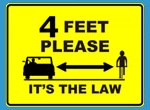<h1>Hills suck!</h1> <p>Part 1 of ...</p> <p>There's an old adage in cycling: If your legs hurt, you're in too high of a gear. If your lungs hurt, you're in too low of a gear. If both your legs and your lungs hurt, you're climbing a hill!</p> <p>No ifs, no ands, no buts, hills suck. It doesn't matter about your level of fitness, how long you've ridden, how fast you ride, hills will suck. Why? Because, the amount of energy it takes to get over a given hill at a given speed is a <em>basically*</em> a constant for your bike and your weight. If you and your road bike weigh 165 lbs together, you'll need to generate about 160 watts to get over Pine Grove Mountain at 5 mph. Using a mountain bike? The extra weight and higher rolling resistance of a big tire won't help you here and requires another 20 watts. Double your speed (a great feat, by the way) to 10 mph and you'll get up there twice as fast, but you'll need an extra 170 watts.</p>
Hills suck!
by post_author );
// If display name is not available then use nickname as display name
if ( empty( $display_name ) )
$display_name = get_the_author_meta( ‘nickname’, $post->post_author );
echo $display_name;
?>
Part 1 of …
There’s an old adage in cycling: If your legs hurt, you’re in too high of a gear. If your lungs hurt, you’re in too low of a gear. If both your legs and your lungs hurt, you’re climbing a hill!
No ifs, no ands, no buts, hills suck. It doesn’t matter about your level of fitness, how long you’ve ridden, how fast you ride, hills will suck. Why? Because, the amount of energy it takes to get over a given hill at a given speed is a basically* a constant for your bike and your weight. If you and your road bike weigh 165 lbs together, you’ll need to generate about 160 watts to get over Pine Grove Mountain at 5 mph. Using a mountain bike? The extra weight and higher rolling resistance of a big tire won’t help you here and requires another 20 watts. Double your speed (a great feat, by the way) to 10 mph and you’ll get up there twice as fast, but you’ll need an extra 170 watts.
OK, so with the fact that hills suck agreed to, how can you go about learning to love, or maybe achieve a fondness for, or at least not loathe the hill that’s between you and your destination?
Well, the quickest way to reduce the amount of work you need to get up a particular hill at a particular speed is to reduce the amount of weight you have to carry up.
That reduction can be from your bike and it’s components. Have a kickstand, but you park at a bike rack every day? Lose it. Have three water bottles attached for your 20 minute commute? Lose 2 (Water weighs 8lbs/gallon). Want to
invest in a lighter bike? Seriously consider it, or at least upgrading from steel to alloy wheels!
Losing 5 lbs from your bike from any of the methods described will save you 4 watts.
Or, the weight reduction can be from you. Lighten up 10 lbs? The amount of work you have to do to get up your nemesis hill is reduced by another 10 watts and now you’re down to 145 from 160.
There are a host of other things you can do, and some of the simplest involve routine
bike maintenance that you want to be doing anyway. Pump up those tires to the maximum
pressure listed on the sidewall. Doing so reduces your rolling resistance and is an immediate
and completely free improvement (and if you ride on pavement 95% of the time, consider smoother, higher pressure tires). Lube your chain regularly and get a tune-up if you’re having shifting issues.
One of the biggest mistakes riders make when tackling hills is to go full power at the start of the slope. That’s a great way to feel like you’re king of the hill, but more often than not, your energy will peter out before you’re even a 1/4 of the way up and everyone will be passing you and wishing you a nice day. Find a speed that’s comfortable for you on the hardest part of the hill and make that your target average speed. It doesn’t matter that it’s 3,4, or 8 mph, but it should be a speed that you can consistently maintain going up the hill. Then, rather than attacking the hill at the bottom, start at or just slightly above your target average speed. You’ll find that when the going gets tougher, you’ll still have some reserves left to power through the really tough spots.
Anticipating shifts can be a great help on hills, too. If you’re halfway up the hill before you downshift, even the best derailleurs can strain under a full-power shift. A mis-shift in the middle of a climb usually leads to a great loss of momentum — and it takes even more energy to get moving again. Get into a lower gear before you need to, and you’ll find that you can keep that precious momentum and use it to your advantage.
On the rollers you find on a lot of Central PA routes, don’t be tempted to pedal fast going down in hopes that you’ll get farther up the next hill. That works occasionally but only if the next hill is smaller than the one you’re going down. If that next hill is the same height or bigger, all you’ll accomplish is to waste energy that you’ll need later. Save that energy! Let gravity pull you down the hill and shift to a medium gear that will not strain your legs and keep you at your target average speed as you climb.
The best way to start liking those hills, though, is to train and increase your power-to-weight ratio. It hasn’t been that long since I thought a 5 mile ride was a tremendous effort. As I ride around the area, I am constantly speeding up little hills that I remember absolutely hating when I first started to become an avid rider. What’s the difference now? I’ve ridden on hills that are much higher than what are now to me little bumps in the road. I’ve increased the distances I can ride so it’s not as much of a stretch to do my daily commute.
How to start training? First off, don’t just ride. You will need to challenge yourself, increasing your distances and speeds. Don’t be scared off by that; you don’t really have to stress yourself out too much. I have found that a few miles a week increase in your longest ride will slowly but surely build up your stamina. If you add a secondary goal to increase your speed by .2 mile/hr at the same time you’re increasing your distances, you’ll also slowly but surely decrease the amount of time/mile — and eventually, you’ll find you can be doing 20 miles when you used to do five. Want to improve even more? Throw in a few intervals — 30 secs at your peak output (i.e., ride as fast as you can) followed by a 2 minute cool-down. Repeat 3-5 times on a ride.
How does that help you on hills? Any increase in your distance/speed ability will be quickly felt as you tackle those hills. If you really want to increase your hill climbing, then you need to tackle more and higher hills. For that, you are in luck! You live in Central Pennsylvania! Pick a hill and try to do it once a week. Time yourself and try to shave 10-20 seconds off of your time each week. That doesn’t sound like a lot, but it will add up.
Loving hills? Well, maybe that was a stretch, but if you face them rather than avoiding them using some of the tips presented here, the rewards to your overall fitness will be great. You’ll soon find yourself not even noticing smaller hills that you hate now. And you’ll get to see what’s over that mountain.
* — see the references below for a full explanation of the physics of riding and hill climbing.
References:
My favorite local hill climbing training routes:
To Where the Pavement Ends
http://www.mapmyride.com/us/state-college-pa/to-where-the-pavement-ends-route-306079
To Where the Pavement Ends (Extended)
http://www.mapmyride.com/us/state-college-pa/to-where-the-pavement-ends-extended-route-15566678
http://bikecalculator.com/wattsUS.html
http://www.cptips.com/energy.htm
http://www.blog.ultracycle.net/2010/05/cycling-power-calculations




